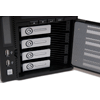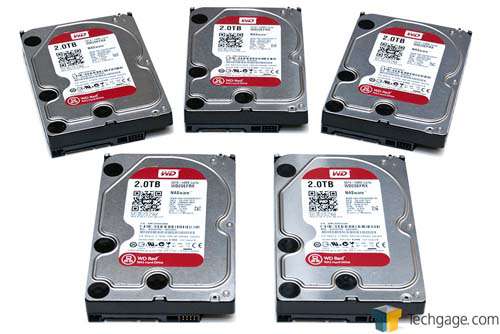- Qualcomm Launches Snapdragon 4 Gen 2 Mobile Platform
- AMD Launches Ryzen PRO 7000 Series Mobile & Desktop Platform
- Intel Launches Sleek Single-Slot Arc Pro A60 Workstation Graphics Card
- NVIDIA Announces Latest Ada Lovelace Additions: GeForce RTX 4060 Ti & RTX 4060
- Maxon Redshift With AMD Radeon GPU Rendering Support Now Available
SysAdmin Corner: Demystifying RAID

Interested in RAID, but not sure which option is right for you? The goal of this article is to clear up any confusion you may have. We discuss what RAID is, what it isn’t, potential dangers, differences between popular RAID levels and last but not least, what you need to get yourself up and running with your very own RAID.
Page 4 – Some Common Uses & Final Thoughts
A lot of people ask, “Why bother?” The answer is dependent on your need. So, I’d like to put forth some good reasons to mess with and sacrifice a little bit of your precious hard drive space to get the benefits of RAID.
Video Server
My home server does a lot for my video needs. It downloads, converts if necessary, organizes and then streams video to various devices in my house. For both the conversion and the streaming, having good read speed is crucial. My personal setup stores the original file on a four-disk software-controlled RAID 5 array (all drives are 5900RPM Seagate 2TB). It does the converting by writing to a drive off of the array, and then writes the verified, converted file back to the array.
Note that the RAID array only gets ‘archivable’ files here – the original, in case something goes wrong during conversion, and the final copy. This is because RAID 5 has wonderful read speed, but writing requires computation of a parity block and is thus much slower – while simultaneously preventing the array from being able to read as quickly. Therefore, I try to minimize the writes, so using it to cache my temporary data is a no-no.
When streaming video, I am capable of saturating my network without running out of hard drive throughput (though I have to stream from more than one device simultaneously!), and load speed even for big movies is under two seconds. Without RAID, trying to stream two 1080p videos to two different devices would surely cause stuttering and buffering issues.
Document/File Server
At work, uptime is critical. Though many smaller offices do not need the benefits of tens of terabytes of data storage right now, having always-on access to the data they do have is vital. Particularly in small offices, hardware failure is more common than corruption. Correcting for this is often accomplished by making multiple backups, and hoping that the most recent one won’t have lost too much data.
In this case, RAID 1 can become a far better solution, and it’s built right into their servers already. It’s not a substitute for good backup habits – but it’s even better if your backups stay backups and your current data stays active and available. RAID 1 allows an office to make a cheap investment of one duplicate hard drive and end up with a failover that can even be switched on-the-fly if a hard drive dies. Most small offices don’t consider this option because they simply don’t realize it exists, and for not having IT staff at their disposal… but not having to resort to backups at a crucial moment can save a lot of time, and time is money.
Gaming
Many of you have heard or seen the benefits that come from using a solid-state drive for your video games. Reduced load times, less hiccups… there are a number of advantages. But here’s something you may not have thought of – a RAID 0 array for your Steam collection makes perfect sense.
Put your saved games on your OS partition for safety (likely done by default anyway), but leave the game data on the RAID array. The low number of writes vs reads means it’s way less likely to fail to begin with, and the speed benefit will be immense. Besides, if the whole array goes down, re-downloading Steam (and your games) isn’t a lot of work. None of the data is irreplaceable, making it a perfect fit for RAID 0’s blistering speed, and the setup is built right into Windows 7. If you really want to future-proof, do it with a couple of SSDs instead of traditional platter-based drives – and watch the proverbial smoke fly. Remember, RAID 0 has no space lost – so you can take a couple cheaper drives to create your gaming beast.
Final Thoughts
We hope you’ve enjoyed this look at RAID – the what, the how and the why. In another (much shorter) feature, I’ll show you how to set up a RAID 5 on a Linux file server, along with basic commands to monitor both your array and the drives that make it.
For now, though, we hope that this has given you a little bit better understanding of what RAID is and how to use it… it’s not just for servers, after all. Whether you use it for your home media, your office files or your games, RAID can have a place in nearly any setup – you just need to know what you’re looking for and which setup will suit that purpose best.
Discuss this article in our forums!
Have a comment you wish to make on this article? Recommendations? Criticism? Feel free to head over to our related thread and put your words to our virtual paper! There is no requirement to register in order to respond to these threads, but it sure doesn’t hurt!
Support our efforts! With ad revenue at an all-time low for written websites, we're relying more than ever on reader support to help us continue putting so much effort into this type of content. You can support us by becoming a Patron, or by using our Amazon shopping affiliate links listed through our articles. Thanks for your support!





